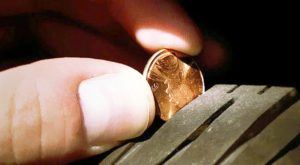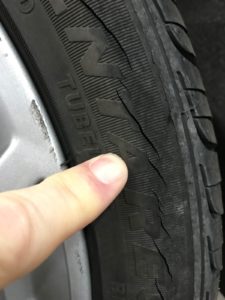
Driving a safe vehicle is important not only for your safety but for the safety of other people on the road as well. That is why checking your tires is an important part of making sure you are driving a safe vehicle.
Here are a few tips on performing an inspection on your tires which you can complete in less than a minute.
If the time comes that you need to replace your tires, let us help find the right tire for your vehicle.
Luxury Tires For Less offers Premium Name Brand Tires at 40%-80% off retail prices.
Check the tread for sufficient depth and uneven wear.
If your tread is worn out, you may not have enough traction to accelerate or brake safely, especially in slippery or wet conditions.
- Place a penny between the tread blocks of your tire with Lincoln’s head facing you and upside down in the tread. If the top of Lincoln’s head is exposed, you need to have your tires replaced.
 Use the penny to check three or more spots around the tire to make sure the tread is wearing evenly. Compare the tread depths to determine if they appear the same.
Use the penny to check three or more spots around the tire to make sure the tread is wearing evenly. Compare the tread depths to determine if they appear the same.- Measure two or three spots across the tread contact patch of your tire. Uneven wear can occur either around the tire or across the contact patch.
- Use the penny to gauge the tread depth and wear on the remaining tires.
- Note any inconsistencies in tread depth on each tire which can indicate a need to have a wheel alignment performed, a suspension or steering repair diagnosed and completed, or a tire balance issue.
- Note any inconsistent measurements between all four of your tires. This can help a mechanic determine the location of a problem.
Check for cracking on the tires.
Cracking occurs on tires when the rubber begins to degrade. It’s common to see fine cracks forming either between the tread blocks or on the sidewalls, but it should never expose the cords or leak air.
 Look at the area between the tread blocks to check for cracking. Fine cracks are a normal part of a tire aging, but they should be monitored regularly to prevent encountering a dangerous driving situation. If there are wide cracks where you can see the steel belts or woven fabric, your tire is not safe to drive on.
Look at the area between the tread blocks to check for cracking. Fine cracks are a normal part of a tire aging, but they should be monitored regularly to prevent encountering a dangerous driving situation. If there are wide cracks where you can see the steel belts or woven fabric, your tire is not safe to drive on.- Check the sidewall for cracking, especially the area between the tread blocks. Minor cracking is normal due to weathering but cracks exposing inner tire layers are a serious condition requiring tire replacement.
- Check for tread separation. On tires with degrading rubber, the tread can separate from the body of the tire. You can see this as large cracks forming at the join between the sidewall and the tread section. If minor cracking is present on only a few tread sections, you can safely operate your vehicle but should keep an eye on the cracking. If the crack is wide enough to fit the corner of a credit card in, the tire should be replaced immediately. Tire failure can result from operating on such a tire.
Check for objects, bulges or punctures in the tire.
- Visually inspect your tire tread for anything that doesn’t belong. Nails, screws, pieces of metal, and large rocks can be embedded in your tire, puncturing the liner and causing a leak. Items puncturing the tire may actually leak very slowly because the puncture is plugged with the object, though it still needs to be replaced very soon.
 Check the sidewall for cuts or protruding objects. Visually check for anything that looks like it doesn’t belong.
Check the sidewall for cuts or protruding objects. Visually check for anything that looks like it doesn’t belong.- Look for obvious bulges or bumps on your tire. Look for egg-sized lumps that feel softer than the rest of the tire when pressed. Bulges or lumps indicate tire separation where air has entered between the rubber layers in the tire. Though it may not leak immediately, it is unsafe to operate your car with a tire separation.
Check your tire pressure.
 Tires that are under-inflated or over-inflated can feel loose when steering and will have an increased stopping distance in panic braking situations.
Tires that are under-inflated or over-inflated can feel loose when steering and will have an increased stopping distance in panic braking situations.